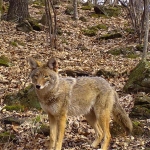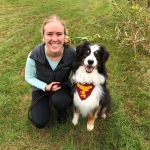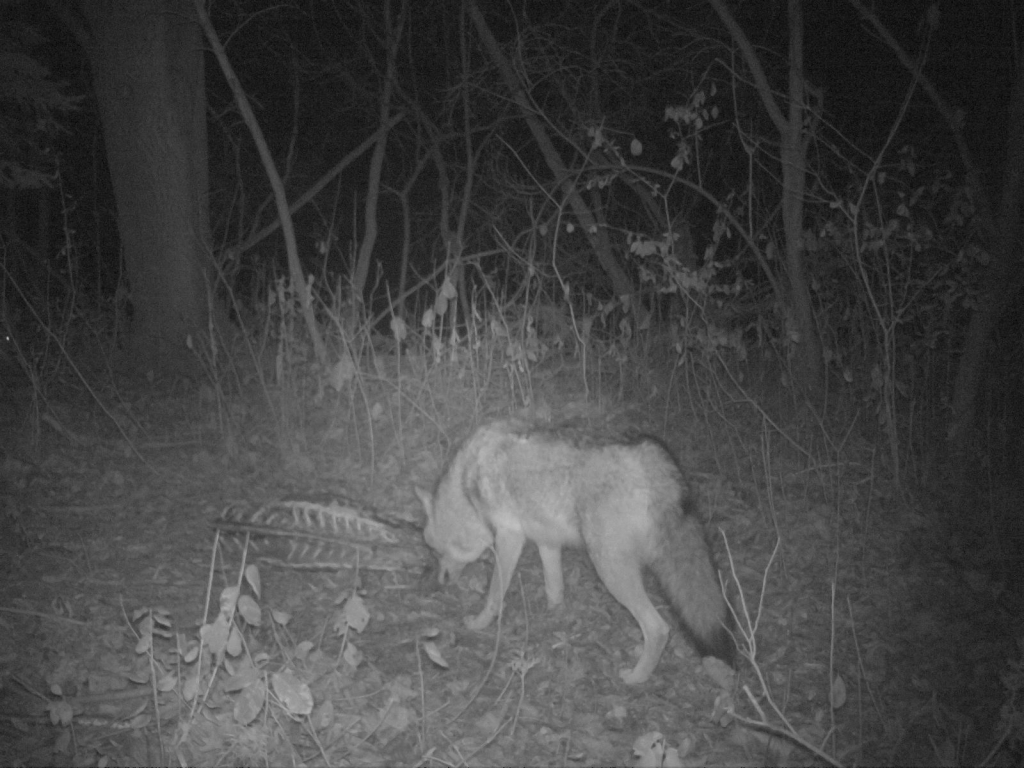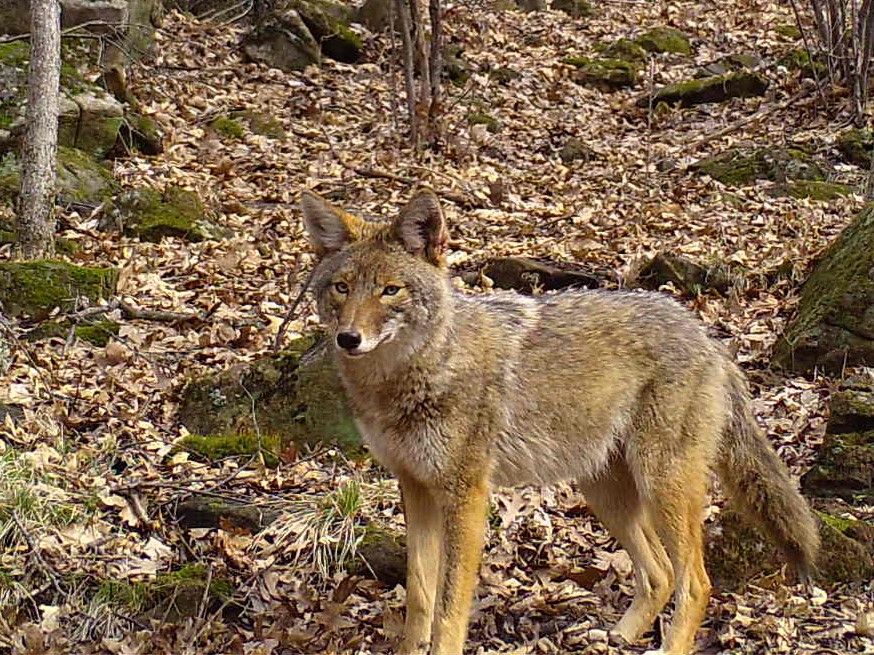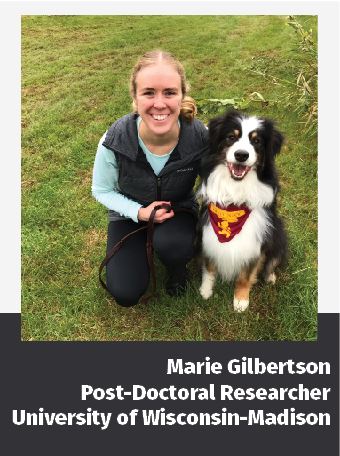November 2021
The research team is wrapping up some of the predator analyses that they are working on, and they are ready to share the results of one analysis in particular, the Coyote Survival and Cause-Specific Mortality analysis. This analysis revealed insights into the lives (and deaths) of coyotes in the study region.
The team also introduces a new collaborator, Marie Gilbertson, who will be leading many of the analyses linked to deer movement and contacts. Gilbertson is a post-doctoral researcher at the University of Wisconsin-Madison, and we are glad she is part of the research team.
Read both these stories in this edition of the Southwest Wisconsin CWD, Deer and Predator Study (SW CWD Study) newsletter.
LEARNING MORE ABOUT COYOTES - RESULTS FROM THE COYOTE SURVIVAL AND CAUSE-SPECIFIC MORTALITY STUDY
The research team shares results from one of the project’s predator studies, and Nathan Roberts, former Furbearer Research Scientist at the DNR, weighs in on what the results tell us about coyotes’ lives in Wisconsin.
STAFF HIGHLIGHT - MARIE GILBERTSON
A new collaborator, Marie Gilbertson, talks about how she will be contributing to the SW CWD Study. Read more about her background and excitement around getting involved in this study.
Learning More About Coyotes - Results from the Coyote Survival and Cause-Specific Mortality Study
As the team wraps up their analyses with the predator collar data, they are developing a deeper understanding of a coyote’s life in southwest Wisconsin.
Nathan Roberts, associate professor at the College of the Ozarks and expert on furbearers in Wisconsin, sat down with the research team to talk about what these new insights say about the lives of coyotes. If you have been following this project, you may recognize Roberts’ name. Roberts used to be a Furbearer Research Scientist at the DNR, and he was one of the main researchers working on the project until he took up his current position in academia.
Roberts described what his role was at the DNR. “I was a research scientist who worked with wolves, bears and other furbearers/carnivores. My role was to design and implement research projects that helped the DNR make informed decisions about these species so that we could manage them on behalf of the public.”
The SW CWD Study is primarily a deer project, and the project’s main goal has always been to determine the past, current and future impact of CWD on deer in Wisconsin. However, carnivores can also impact the deer population, so the team knew they needed to include predators in the study.
Roberts explained, “If you are a deer in southwest Wisconsin, the types of things you need to worry about are disease, habitat and things that will kill you [like cars, predators and hunters]. We won’t be able to see the full picture without including factors like habitat and predation in our study.”
A Large Sample Size Builds Confidence
Thanks to the help of landowners and trappers, our study included data from 68 unique coyotes. This sample size is one of the largest studies of coyotes in the reported literature, according to Roberts.
A large sample size is important when looking at survivorship because it helps buffer against the impact of rare occurrences. “Imagine an experiment with only ten coyotes. If two were hit by a train, then you might conclude that 20% of coyotes get killed by trains each year. However, we know that getting hit by a train is a rare event for coyotes, so that [take-away] would be misleading. Having a larger sample size helps protect against odd deaths throwing the data off,” said Roberts.
Due to our large sample size, the research team is confident that the results accurately represent what is happening in the larger coyote population in southwest Wisconsin. Furthermore, there also was an even mix of males and females in the study, which gave Roberts additional confidence that the study’s results would apply to the broader coyote population.
Coyote Survival
When researchers talk about survival, they are usually talking about the odds of an animal living for the next year. Survival is calculated as a number between 0.0 and 1.0, where 0.0 is a 0% chance of any individual surviving the year. Conversely, a survival rate of 1.0 means all individuals have a 100% chance of survival. It may be easier to think of survival out of 100 individuals. If you expect 60 of them to survive till the next year, then you should expect a 0.6 survival rate.
The opposite of the survival rate is the mortality rate, which is the proportion of individuals that you expect to die in the next year. A population with a 0.6 survival rate will (by definition) have a 0.4 mortality rate, because 40% of the population died. Finding these values for a population gives us an idea of how much turnover there is each year and can inform management decisions like quotas.
In our study, the team found a .53 survival rate for coyotes with no difference between males and females. This survival rate is what Roberts expected to see, essentially a flip of a coin for each individual. “If you look at similar studies across a range of species, this survival rate is right in the middle. It isn’t a super high mortality or a super low mortality,” said Roberts.
To demonstrate his point, Roberts brought up two studies on coyotes in Illinois. Roberts said that researchers Van Deelen and Gosslink (in 2006) found an average coyote survivorship of .59, while Lloyd (in 1998) found coyote survivorship rates to range between 40-50%. Our results fall right in the middle of these two estimates.
However, calculating the survival rate is just step one. We needed to understand how and why coyotes die. For that, researchers need to tease apart mortalities by their causes.
What Is Cause-Specific Mortality?
Cause-specific mortality is a breakdown of what killed coyotes. Were the deaths due to disease or starvation? How big of a force was hunting? Did coyotes die from territory disputes or injuries from hunting prey? Knowledge about what caused each death helps us understand which forces impact coyotes and how strong the forces are.
So far, 46 of the 68 coyotes have died since the study began. A coyote’s collar is programmed to send a signal to staff when the coyote hasn’t moved for several hours. Researchers then traveled to the site to determine why it died.
The necropsies, or animal autopsies, concluded that 35 coyotes were killed by hunters (one additional coyote was killed illegally). Five coyotes died from car collisions, in addition to two deaths from injuries, one from disease and two from unknown causes.
Collectively, 41 of these mortalities were related to human activity (hunting and car collisions). Only three were conclusively from nonhuman-related mortalities (not including the two unknown mortalities).
Roberts was surprised to see so many mortalities were from human activity. He expected more mortalities from environmental forces like injury and disease.
Mortality Rates Changed Throughout The Year
Researchers also found that the highest mortality rate was between October and March. The rate during this time was three times higher (.39) than the rest of the year (.13).
“People hunt coyotes more in the fall and wintertime,” said Roberts, “because they are easier to hunt and are worth a good price. The young ones also disperse in late Fall and try to find their own territory. They are more likely to get hit by cars or run into a hunter as a result.”
In contrast, the young stick close to their mother throughout the spring and summer months, so it is less likely to see them. The mother also isn’t going far from the den. She is just focused on bringing back food.
The difference in their lifestyle, as well as the opening of the trapping season in mid-October, likely cause the increase in mortality seen during the late fall and winter.
The Resilience Of The Population
Roberts had an interesting take on how these results fit into our understanding of coyotes’ lives.
Coyotes are related to dogs, just like wolves and foxes are. People often assume that means that coyotes live as long as domesticated dogs, but Roberts said their lifespans are quite different. “The majority of hunted and trapped coyotes are less than three years old. That suggests to us that most of the population is quite young,” said Roberts. A survival rate of .53 means that only half the population survives each year, which also supports the idea that coyotes have a lot of turnover each year.
However, coyotes are quite abundant, so they must be able to handle this turnover rate somehow. We know coyotes are a generalist species, meaning that they take advantage of a wide variety of food resources. “We expect coyotes to be opportunistic and eat what is available to them [and easiest to catch],” said Roberts. “In southwest Wisconsin, their diet is mainly comprised of small animals like rabbits and rodents, but they also will eat insects and vegetables as needed. Coyotes will sometimes eat deer, especially fawns [if they can find them]. However, deer are not considered their main food source.”
Coyotes also have a few abilities that help them handle their mortality rate. For example, they tend to have larger litter sizes and can breed early on. “Unlike many other furbearers, they don’t have to wait until their second year to breed. Coyote pups born this Spring can breed this Winter,” said Roberts.
Their oddest ability is adjusting how many new coyotes are added to the population each year. Roberts said he doesn’t think the mechanism is known yet for how they make this adjustment, but it may be linked to changing their litter size or the survivability of the litter to adulthood. Roberts speculated, “It might be linked to habitat and food availability. Those who survive may get their pick of prime real estate and are less likely to fight with others over territory and food.”
This reproductive ability, in combination with their ability to eat most food sources, is what allows coyotes to be so abundant in Wisconsin, despite high hunting pressure. Roberts said, “When I look at this data, it tells me that we have a lot of coyotes, and their population is doing well for itself.”
Thanks to this study, we know a bit more about the coyote population in southwest Wisconsin, but there is more to come. This study is only one of a few predator studies the research team is currently wrapping up, so stay tuned.
Stay Tuned For The Remaining Predator Studies
Once the team wraps up the remaining predator studies, the results will be shared in this newsletter, so don’t miss out on what’s to come. In particular, the team has nearly completed an analysis on how predators move and use different habitats. That study should be interesting to many different groups of people across the state.
Before parting ways with us again, Roberts shared some final words for those who helped make this study possible.
“I want to thank the public. Without the trappers, we likely wouldn’t have been able to include so many coyotes in the study. You were instrumental in the success of the study.
Also, the landowners helped a ton. To put a collar on an animal, we need permission from the landowner to be on their property. After the coyote has a collar, we have no control over where it goes [and where it dies], so our ability to reach the animal again depends on a second landowner’s permission. Without permission from both landowners, we couldn’t have included so many coyotes in this study.
This study has been a collaborative effort. We wouldn’t have been able to do this type of study and have all this data without your cooperation. Thank you.”
Staff Profile - Marie Gilbertson
What Is Your Role In The SW CWD Study?
“I get to dive into questions about how deer movement relates to CWD transmission, but I am focusing on deer dispersal right now. Among juvenile deer that have been collared, I am asking questions about how many disperse, how far they go, which directions they disperse and what kinds of landscapes they use while moving,” said Gilbertson.
Gilbertson is also working on a few other pieces of the SW CWD Study. Specifically, Gilbertson will be working on the last five analyses on the project timeline (under the “Other Deer and Predator Studies” section):
- Juvenile dispersal
- Impact of CWD on deer movement
- Deer movement, activity and habitat selection relative to breeding and hunting
- Seasonal deer movement and habitat use
- Deer contacts
We are excited to see what Gilbertson discovers on these topics.
How Will Your Background Help While Studying CWD And Deer Movement?
Gilbertson has both a veterinary degree and a PhD in Veterinary Medicine, which gives her a unique perspective on deer behavior and movement.
During grad school, she worked on understanding how contact networks of Florida panthers influenced the spread of viruses within the population. “I was trying to identify the underlying drivers of transmission. Do we see more transmission between panthers that are closer to each other, or do we see more transmission based on age or sex? I also was thinking about how to use that information to optimize management of the species,” said Gilbertson.
Gilbertson continued. “I have a strong background of thinking about health at both an individual level and population level. People tend to talk about veterinarians as being focused on individuals, but when you go into production animal medicine, you need to think about whole herds. Veterinarians also lean in to One Health principles, thinking about how animals, humans and the environment are all interconnected.”
“During grad school, I learned tools and ways of thinking about movement and transmission. In this study, we are linking movement ecology and disease ecology together, so graduate school prepared me well for that [part of the job],” said Gilbertson.
What Are You Excited To Learn?
“Everything!” Gilbertson said without hesitation. “Some of the bigger questions I am interested in tackling, if not fully answering, are:
- How does deer movement shape where CWD [accumulates] in the environment?
- How does CWD deposition relate to transmission?
- Who is likely to transmit CWD to each other and under what conditions?
- How might changes in who is interacting with whom affect where CWD ends up in the environment?”
Gilbertson also said that one thing she thinks is an exciting part of this project is that we know the CWD status of so many deer. “That information gives this research a lot of power,” said Gilbertson. “We have enough data from CWD-positive animals that we can use it to understand how CWD and movement influence each other.”
Gilbertson continued. “There aren’t many other researchers who can investigate these questions because they don’t have the same kind of dataset. It’s exciting to work with this data and collaborate with the rest of the research team.”


